Over the Fourth of July Holiday, one of our stops included Lassen Volcanic National Park. The theme of our two-week adventure was “hidden gems†and while most people have heard of Lassen, only about 370,000 people visit it, each year. By comparison, about 3.5 million people visit Yosemite National Park, every year. That’s a shame, because Lassen is one of the most unique and interesting places in North America and if you have future plans to visit some of the great western parks, be sure to set aside three days for Lassen.
Key Travel Information
From Yosemite Village, the Highway 44 entrance to Lassen (at Manzanita Lake) is 350 miles by car, or about 7 hours. Crater Lake National Park is 230 miles by car, or about 4 hours. The nearest major airport is Redding (RDD), which is 45 miles from the Highway 44 entrance to Lassen. The Redding airport is serviced by Alaska/Horizon and United airlines, with daily direct flights from Los Angeles and San Francisco. Avis, Budget and Enterprise car rentals are available at the airport.
Day 1: Lassen Peak and Bumpass Hell
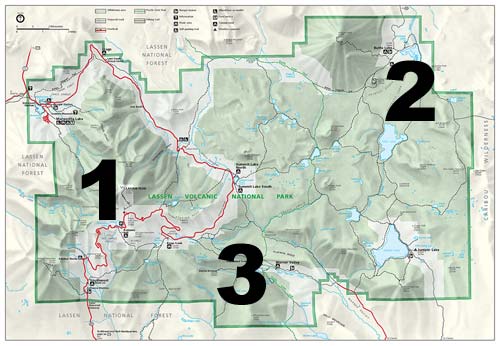
The three major areas of Lassen; Lassen Peak and Bumpass Hell (1), Cinder Cone and Painted Dunes (2) and Devil's Kitchen (3)
Lassen is not an easy park to get around in, because the three major areas of the park are not connected by a single road system. The vast majority of people who visit Lassen only see the major attractions along the Lassen Peak Highway (1 on the map), which runs from the Highway 44 entrance station in the north, to the visitor’s center near Highway 36 in the south.
Devil’s Kitchen, in the Warner Valley (3 on the map), is only three miles from the Lassen Peak Highway, but reaching it requires an hour drive out the southern end of the park and back around through the town of Chester. Likewise, traveling to Cinder Cone (2 on the map) is an hour drive over the top of the park.
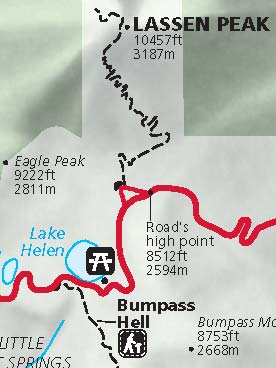
The Lassen Peak trailhead and Bumpass Hell
Granted, there is a lot to see along the Lassen Peak Highway, including Lassen Peak itself. The Lassen Peak Trail gains about 2,000 feet, from the trailhead near Lake Helen, to the summit at 10,457 feet. Just across the highway from Lake Helen is Bumpass Hell, which is the largest area of geothermal activity in the park.
This section also marks the summit of the Lassen Peak Highway, at 8,512 feet. We arrived at Lassen on July 7th and the highway was still closed due to snow. Luckily, the Park Service opened the road on July 8th, but Bumpass Hell was still buried in snow and remained closed. Lassen Peak receives more annual snowfall than any other location in California, so keep this in mind when planning your trip.

Snow accumulation along the Lassen Peak Highway, after it opened on July 8th
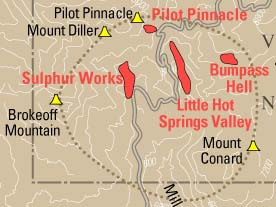
Outline of the ancient Mount Tehama
Further south along the Lassen Peak Highway is the Sulfur Works geothermal area, featuring several mud pots and steam vents. Though Sulfur Works is a relatively small area, it is an interesting stop because it marks the geographic center of the ancient 11,500 foot tall Mount Tehama. The remnants of Mount Tehama include Mount Diller, Brokeoff Mountain and Mount Conard – a diameter of nearly 11 miles.
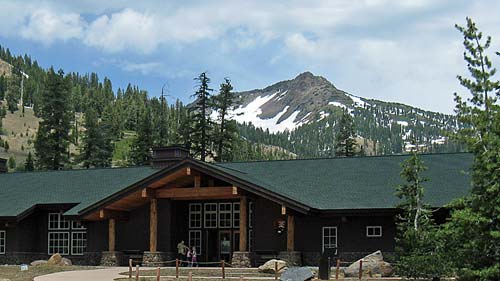
The Kohm Yah-mah-nee Vistor Center at the southern end of the park
Finish up your first day with the visit to the Kohm Yah-mah-nee Vistor Center, at the southern end of the Lassen Peak Highway. You can grab a bite to eat, browse the gift shop and explore the multimedia exhibits.
Day 2: Cinder Cone and Painted Dunes
Despite ending the first day at the visitor center, in the southern end of the park, choosing one of the campgrounds on the northern end of the Lassen Peak Highway will set you up for a quick exit to Highway 44, the next morning, in order to get up and over the park to Cinder Cone (area 2 on the map).
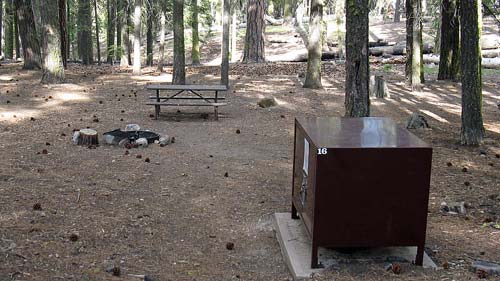
A typical campsite at Crags
We chose the Crags campground, which has 45 first-come, first-served sites. When we arrived, on a Wednesday, we were the only ones in the campground. That may not be the case later in the season, but Crags does not have the amenities found at the more popular Manzanita Lake campground (179 sites). Crags has fire pits, picnic tables, a bear box and plenty of flat ground for a tent – just right, for our needs.
The hike to Cinder Cone is about two miles (three, if you continue to Painted Dunes), with an elevation gain of 1,000 feet. If that sounds easier than the Lassen Peak Trail, don’t be fooled – it is like hiking on beach sand, only uphill (and at 6,000 feet!). It is not to be missed, though.
Like Lassen Peak, the reward for hiking Cinder Cone is the view – in this case, Painted Dunes, Fantastic Lava Beds and the distant peaks in the park. It is a great area of the park to spend a day and you won’t have to worry about fighting the crowds.
Day 3: Devil’s Kitchen
If Bumpass Hell seems a bit too civilized, with its fancy boardwalks and safety railings, then Devil’s Kitchen (area 3 on the map) is the place for you! Devil’s Kitchen is only slightly smaller than Bumpass Hell and, at 6,000 feet Devil’s Kitchen is accessible earlier in the season, when Bumpass Hell is still buried in snow.
The two-mile hike to Devil’s Kitchen is relatively flat, with an elevation gain of only 440 feet. It is also through forested meadows, instead of volcanic rock and cinders. It is a pleasant hike, even with the kids, and the steaming pools, boiling mud pots and colorful mounds of red and yellow steam vents make you feel like you have stepped-back into the Mesozoic.
It is hard to believe that Lassen Volcanic National Park is only an hour from the main arterial corridor (Interstate 5) that traverses that west coast of the United States. Experiencing Lassen is like stepping back 65 million years in time, particularly if you make the extra effort to visit the two remote sections of the park, Cinder Cone and Devil’s Kitchen. Yes, Yosemite is great, as are the coastal redwood forests, but don’t forget about Lassen when you plan your next west coast adventure.
See also…

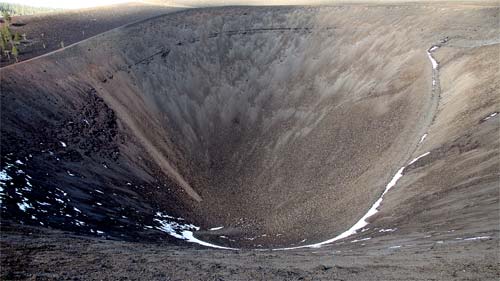
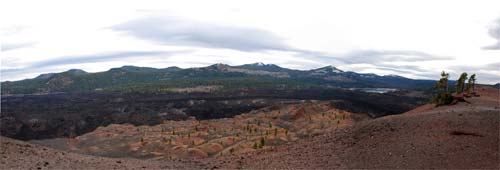
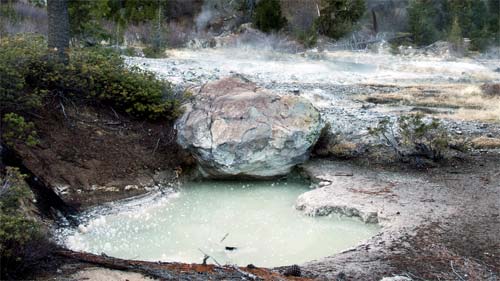
I may be repeating myself, but it sounds like a trip to the Lassen National Forest’s Visitor Center would be a great alternative. Check out their flyfishing basket with its true sound effects. Pretty cool. Plus both children and pets can explore the area.
As one parent to another, AVOID the Junior Ranger programs. We visited almost 12 National Parks this summer and enjoyed the Ranger programs at all of them, except Lassen. Not only was the woman who ran the program (and apparently runs all JR programs) very snotty about our child’s age being too young (regardless with his volcanic knowledge and ability to prove her wrong twice) she talked down to all the kids. The program was also over 2 hours long, they didn’t want any parents to stay, and it involved reading cards with pictures on them to the kids rather than showing them the awesomeness of the park. Children weren’t even allowed to write their names on the Junior Ranger booklets because they “might write too sloppy and ruin it.” We wound up missing most everything in park due to waiting for the program to begin and the length of time it took. As I said, all the other Junior Ranger programs were awesome and really encouraged participation in the National Park, questions, and conservation. Not at Lassen. Don’t waste the time and actually show kids how great the park is!
They have a Junior Ranger program? 🙂 (is that at Manzanita Lake?)That’s good to know, though – I would hate for the kids to get stuck in something like that.
Lassen NP is great but next time I would recommend you consider camping at Lassen National Forest’s Hat Creek or Cave campgrounds. Not sure why but the creek provides better fishing opportunities for children than adults. Just a thought.
Thanks, Suzi – both of those are certainly closer to the Cinder Cone area, than anything in the park. Of course, the downside right now is all the construction that you would have to go through, to get in and out of the Manzanita Lake entrance.
I really enjoyed your blog. I have never been to Lassen Park. I have been to Yellowstone Park and loved it, I hope someday to get to Lassen also! PS: Your pictures are wonderful
Thanks, Pat! I sure hope you get to Lassen, someday – we loved it and will sure try to make it a regular destination.
Wow, this is really one of the best outdoor blogs out there. Its a great combination of photos, informative writing, and a sense that the blog is made by someone with a passion for the outdoors.
Thanks! I really appreciate it 🙂
Roy, I’m glad you made it to Lassen Park, one of my favorite areas to hike and explore. I may actually be headed that way tomorrow, depending on how I decide to end my current trip.
And I was just in Yosemite. It’s a total zoo and far more crowded than Lassen.
I hope you two make it to Lassen on your way home, John!
Agreed. Nicely done. Our summer trip included a couple of days at Craters of the Moon, which I’ve always enjoyed because the volcanism feels so fresh (1500 years or so). But Lassen, that’s just yesterday, so to speak. Thanks for the inspiration.
“I wish to be an inspector of volcanoes” –Edward Abbey
I love Craters of the Moon, Clark. I had never even heard about it, and one year when I was driving over to Idaho Falls for business, I decided to cut through Idaho, instead of driving around it on the freeway, like I had done before (boring drive!). All of sudden I was in Craters of the Moon and I couldn’t believe it – it was so surreal! Then, of course, there is Arco, ID – who would have thought that nuclear power began in Idaho?
Thanks for all the great detail. Hope to visit this place someday.
I hope you do, Debi!